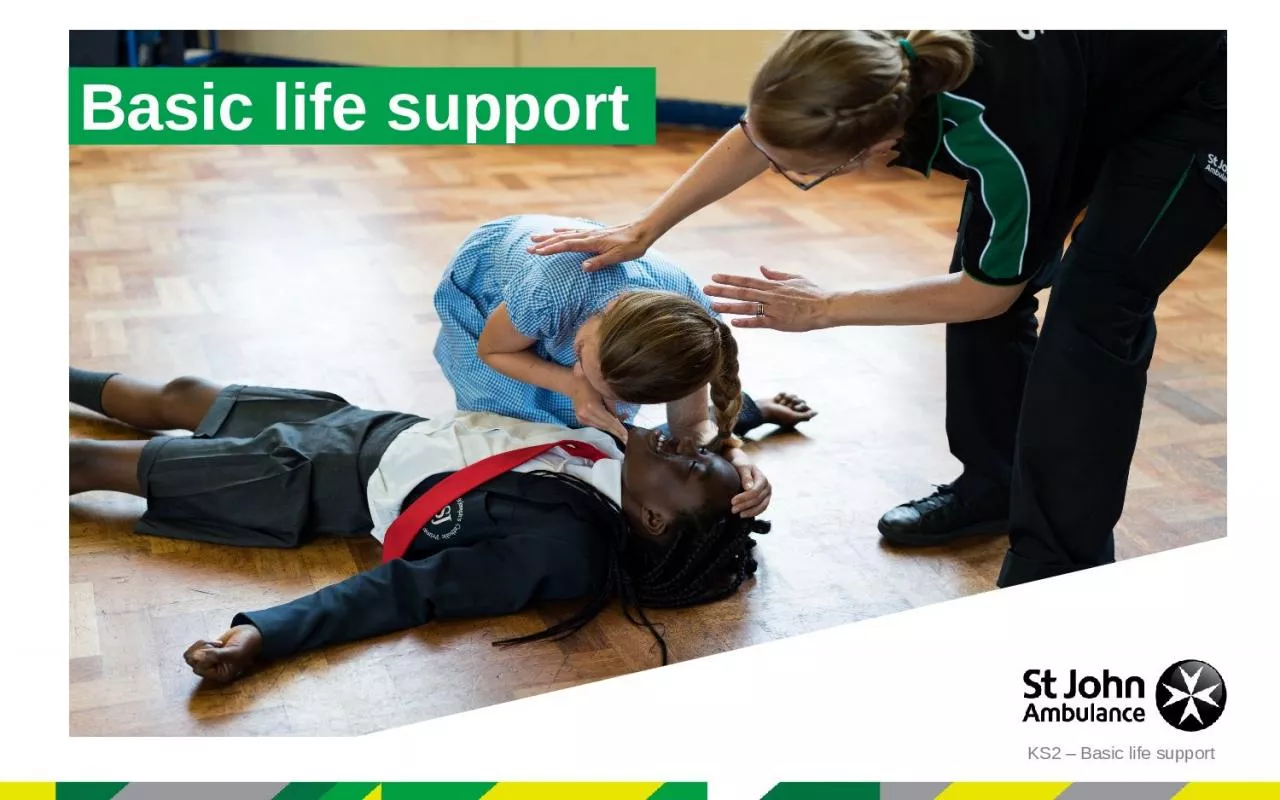

Casualty care A17 There are lots of things to remember when taking care of somebody Which three of these casualty care actions do you think are the most important Remain calm Reassure the casualty ID: 999359
Download Presentation The PPT/PDF document "Basic life support KS2 – Basic life su..." is the property of its rightful owner. Permission is granted to download and print the materials on this web site for personal, non-commercial use only, and to display it on your personal computer provided you do not modify the materials and that you retain all copyright notices contained in the materials. By downloading content from our website, you accept the terms of this agreement.
1. Basic life supportKS2 – Basic life support
2. Casualty care A17There are lots of things to remember when taking care of somebody.Which three of these casualty care actions do you think are the most important?Remain calmReassure the casualtyTreat the casualty with dignity and respectGet helpCommunicate wellPrevent the condition from worseningNo food or drinkKeep the casualty warm
3. Calling for helpKS2 - Basic Life SupportIf there is an e_ _ _ _ _ _ _ y you can dial 999 or 112 to get the emergency servicesThe call operator will ask, “Which service do you require?’’ F_ _ _, P_ _ _ _ _ or A_ _ _ _ _ _ _ _? You will need to tell them which service you needIt is really important that you give information to help them arrive at the correct location i.e. address
4. Remember LIONELKS2 - Basic Life SupportLocation. Tell them where the emergency is and where you want them to arriveIncident. Tell them what has happenedOther services. Do you need more than one?Number of people that are involvedExtent of the injuries. What types of injuries do people have?Location. Repeat again where they need to arriveQuestion:Do you know the correct addresses for two or three places you often visit?
5. 999/112 callsKS2 - Basic Life SupportThumbs up if the information is key to a 999/112 callThumbs down if it is not relevant informationWhat you had for tea last nightWhat happenedWhat football team you supportWhere you areWhat is wrong with the casualty
6. Primary survey KS2 - Basic Life SupportChoose the correct word for each part of the primary surveyChallenge: Why is it important we use DRsABC?
7. Primary survey KS2 – Basic Life SupportChoose the correct word for each part of the primary surveyChallenge: Why is it important we use DRsABC?
8. Watch this videoKS2 – Basic life supporthttps://youtu.be/lCMhuRM0cIU
9. Your turn: Primary surveyKS2 – Basic Life Support1. Check for dangerAlways make sure the area is safe2. ResponseCheck the casualty’s response. Ask questions and gently tap shoulders. Say “open your eyes!”3. Shout for helpAnyone nearby can assist you4. AirwayIf not clear, then open by tilting the head back, use one hand on forehead and two fingers under the chin5. BreathingCheck for normal breathing. Use look listen and feel to check. (Remember 10 seconds!) 6. Circulation (only if breathing normally)Check the casualty for bleedingNBIf the casualty is not breathing normally call 999/112 then start CPRIf the casualty is breathing normally place them in the recovery position then call 999/112
10. RecapDangerResponse ShoutAirwayBreathingCirculation
11. Watch this videoKS2 – Basic life supporthttps://youtu.be/ubbZU15-ETM
12. Your turn: Recovery positionKS2 – Basic Life Support1. Kneel By the side of your casualty2. Angle armPut the arm nearest to you to make a right angle. Palm facing upwards3. Hand to cheekBring the arm furthest away across the chest and place the back of their hand against the cheek nearest to youHold it there4. Knee bendWith other hand, bend their far knee up so that the foot is flat on the floor5. Knee pullPull on the knee to roll the casualty towards you onto their sideAdjust them as necessary6. Ensure airway is openRecheck breathingCall 999/112Stay and monitor casualty until help arrives
13. Watch this videoKS2 – Basic life supporthttps://youtu.be/zZAIA7Iqhyo
14. If you are a young person , you may not be strong enough to do CPR. That’s OK, you can tell someone else what they need to doIt’s important to know that sometimes even CPR cannot help someone if they are really poorly Anything you can do to help, even just calling for help, will be really usefulNever do CPR on someone if they are awake and breathing normallyCPR
15. Your turn: CPRKS2 – Basic Life Support1. Call 999/112Kneel by the side of your casualty Send a bystander for an AED if one is available 2. Place one hand..On the centre of the chestPut the heel of the other hand on topInterlock your fingers to lift them off the chest3. Begin chest compressionsLean over with your arms straightPress downwards on breastbone 30 times 4. Press downTo a depth of about 5-6cmRelease the pressure but leave hands in placeTry to press at a rate of 100-120 times per minute 5. Breathe into casualtyopen the airway and pinch the nostrils togethertake a breath and blow into the mouth until the chest risesrepeat to give two breaths6. Start compressions again repeat 30 chest compressions with two breaths until help arrivesNEVER do this on someone if they are awake!